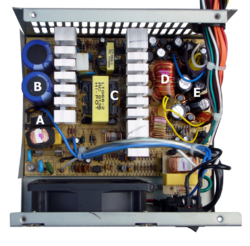
Back المحول المفتاحي Arabic সুইচড মোড পাওয়ার সাপ্লাই Bengali/Bangla Font commutada Catalan Spínaný zdroj Czech Switch-mode-strømforsyning Danish Schaltnetzteil German Fuente conmutada Spanish Pinge impulss-stabilisaator Estonian Iturri kommutatu Basque منبع تغذیه سوئیچینگ Persian

A: Bridge rectifier;
B: input filter capacitors;
Between B and C: heat sink for switching active components of primary voltage;
C: transformer:
Between C and D: heat sink for switching active components of at least five secondary voltages, per the ATX specification;
D: output filter coil for the secondary with the largest power rating. In close proximity, filter coils for the other secondaries;
E: output filter capacitors.
The coil and large rectangular yellow capacitor below the bridge rectifier form an EMI filter and are not part of the main circuit board.

A switched-mode power supply (SMPS), also called switching-mode power supply, switch-mode power supply, switched power supply, or simply switcher, is an electronic power supply that incorporates a switching regulator to convert electrical power efficiently.
Like other power supplies, an SMPS transfers power from a DC or AC source (often mains power, see AC adapter) to DC loads, such as a personal computer, while converting voltage and current characteristics. Unlike a linear power supply, the pass transistor of a switching-mode supply continually switches between low-dissipation, full-on and full-off states, and spends very little time in the high dissipation transitions, which minimizes wasted energy. A hypothetical ideal switched-mode power supply dissipates no power. Voltage regulation is achieved by varying the ratio of on-to-off time (also known as duty cycles). In contrast, a linear power supply regulates the output voltage by continually dissipating power in the pass transistor. The switched-mode power supply's higher electrical efficiency is an important advantage.
Switched-mode power supplies can also be substantially smaller and lighter than a linear supply because the transformer can be much smaller. This is because it operates at a high switching frequency which ranges from several hundred kHz to several MHz in contrast to the 50 or 60 Hz mains frequency. Despite the reduced transformer size, the power supply topology and the requirement for electromagnetic interference (EMI) suppression in commercial designs result in a usually much greater component count and corresponding circuit complexity.
Switching regulators are used as replacements for linear regulators when higher efficiency, smaller size or lighter weight is required. They are, however, more complicated; switching currents can cause electrical noise problems if not carefully suppressed, and simple designs may have a poor power factor.
© MMXXIII Rich X Search. We shall prevail. All rights reserved. Rich X Search